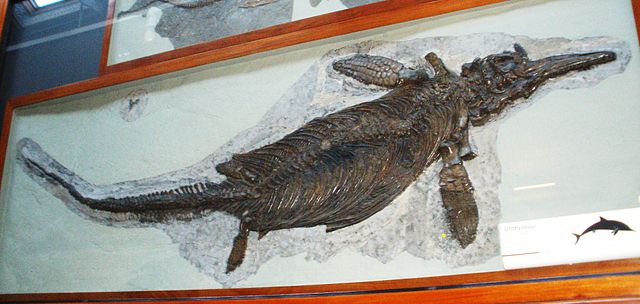After its discovery in the mid-1990s, the Ichthyosaurus or “sea dragon” fossil is making headlines once more due to a surprising discovery: it was pregnant.
The sea dragon fossil was originally found on the Somerset coast, and hails from the Early Jurassic period. It remained unstudied for years, until it ended up in the collection of the Lower Saxony State Museum in Hannover, Germany, the New York Post reports. Scientists estimate that the dinosaur was 200 million years old.
In 2016,paleontologist Sven Sachs of the Bielefeld Natural History Museum noticed the fossil while on a visit, and got in touch with Dean Lomax of the University of Manchester, also a paleontologist and an expert on Ichthyosaurs.
The pair found that, aside from being the largest of its kind on record at 9 to 11.5 feet in length, the specimen was carrying an embryo. The embryo was still developing, according to the scientists, and had a part of its backbone, a forefin, ribs and a few more bones. The tiny dinosaur measures a mere seven centimeters.
Dean said,
It amazes me that specimens such as this [the biggest] can still be ‘rediscovered’ in museum collections. You don’t necessarily have to go out in the field to make a new discovery. This specimen provides new insights into the size range of the species, but also records only the third example of an Ichthyosaurus known with an embryo. That’s special.
Sachs said, “It is often important to examine fossils with a very critical eye. Sometimes, as in this instance, specimens aren’t exactly what they appear to be. However, it was not ‘put together’ to represent a fake, but simply for a better display specimen. But, if ‘fake’ portions remain undetected then scientists can fall foul to this, which results in false information presented in the published record.”
The Ichthyosaurus is one of the most common fossil reptiles in the United Kingdom, with thousands of specimens ranging from single bones to complete skeletons unearthed in the past decades.
The study was published in Acta Palaeontologica Polonica.
























